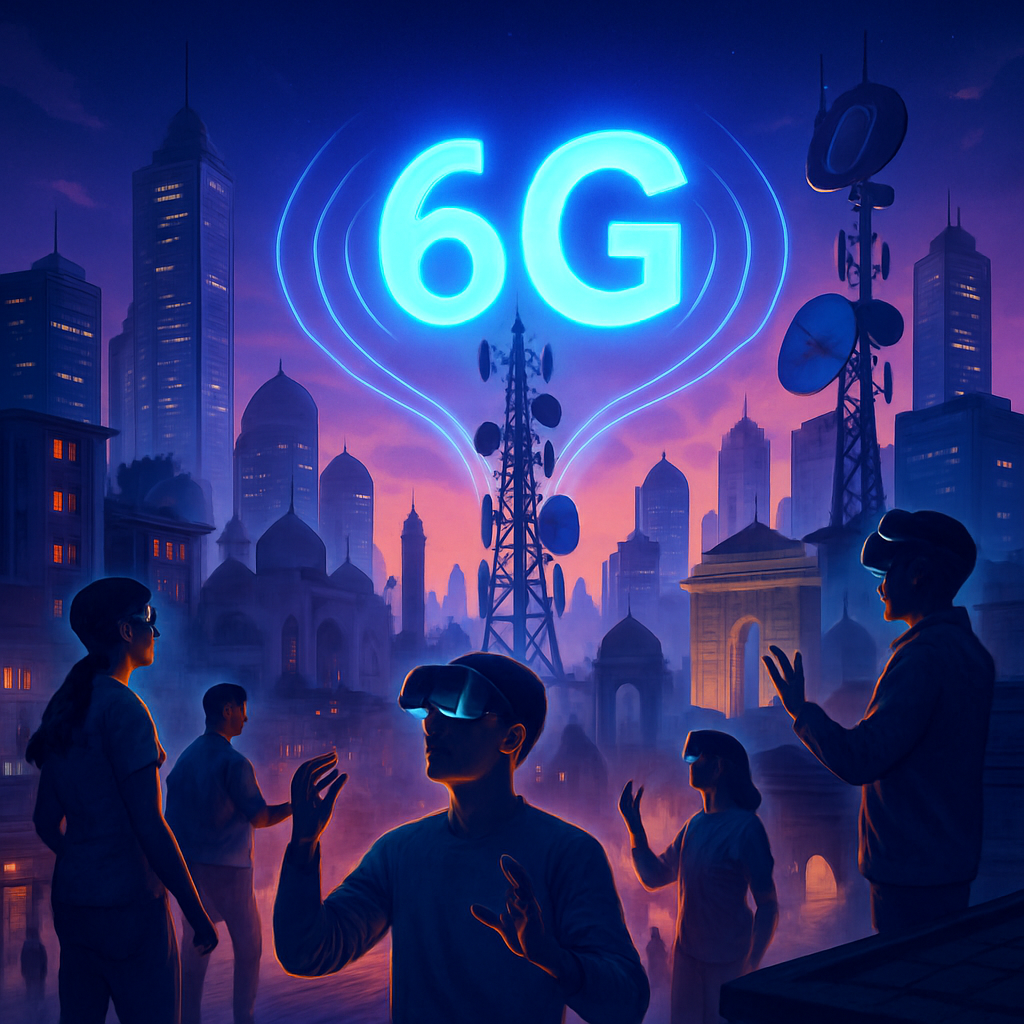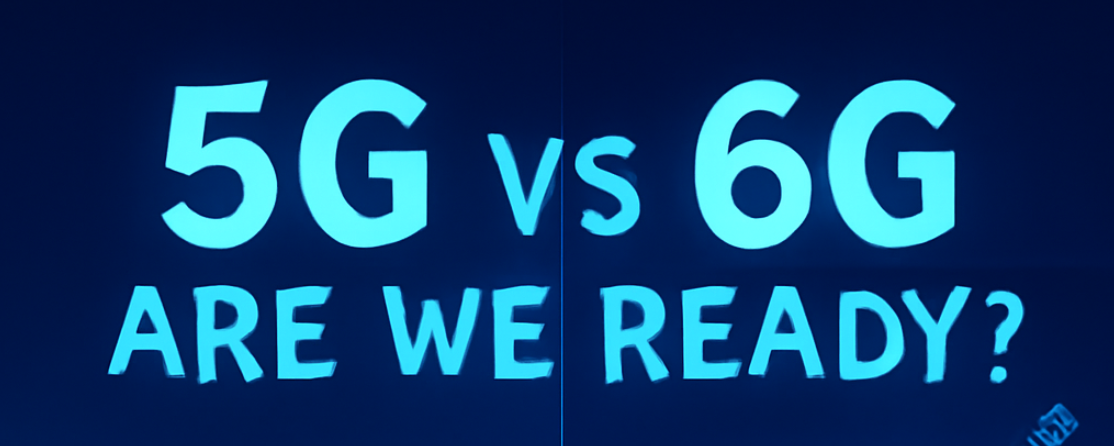5G vs 6G in India: What’s Next After the 5G Rollout?
India witnessed a major leap in digital technology with the rollout of 5G in 2022–2023. Faster speeds, ultra-low latency, and seamless connectivity changed how Indians stream content, play online games, attend video classes, and use mobile apps.
Now, as we step into 2025, the world is already preparing for the next big evolution in wireless communication — 6G.
But what exactly is 6G?
How is it different from 5G?
And more importantly, is India ready for this technological shift?
In this blog, we’ll break down the differences between 5G and 6G, explore real-world examples, and look at India’s position in the global 6G race.
What is 5G?
5G stands for Fifth Generation Mobile Network. It is the successor to 4G and was designed to handle far more data, connect more devices, and deliver faster speeds than ever before.
Key Features of 5G:
-
Speed: Up to 10 times faster than 4G
-
Latency: 1 millisecond (almost real-time)
-
Device Support: Handles millions of devices per square kilometer
-
Use Cases: IoT devices, cloud gaming, smart cities, HD streaming
Where You’re Already Using 5G in India:
-
Faster movie and app downloads
-
Buffer-free video streaming (4K/8K)
-
Online multiplayer gaming without lag
-
Video calls and online classes with better clarity
-
Smart traffic systems, live CCTV feeds, connected streetlights
Telecom providers like Jio, Airtel, and Vi have already deployed 5G networks across major cities and tier-2 towns. As of 2025, over 500 million Indians are estimated to use 5G-enabled smartphones.
What is 6G?
6G is the Sixth Generation of wireless technology, expected to arrive around 2030.
Although commercial 6G networks aren’t available yet, research and testing are already underway globally — and India is a part of it.
Expected Features of 6G:
-
Speed: Up to 1 Terabit per second (Tbps) — around 100x faster than 5G
-
Latency: As low as 0.1 milliseconds
-
AI Integration: Smart, self-optimizing networks using Artificial Intelligence (AI)
-
Device Density: Up to 10 million connected devices per square kilometer
-
Advanced Use Cases: Real-time holographic communication, remote surgeries, AI-driven metaverse, and brain-computer interfaces
In simple terms, 6G will blur the line between the digital and physical worlds.
5G vs 6G: What’s the Difference?
1. Speed
-
5G offers speeds of up to 10 Gbps.
-
6G will push this to 1 Tbps (that’s 1,000 Gbps!) — almost like downloading a full HD movie in less than 1 second.
2. Latency
-
5G has a latency of 1 millisecond — already great for online gaming and video calls.
-
6G will reduce this to 0.1 milliseconds, enabling instantaneous communication, ideal for robotics and remote surgeries.
3. Number of Devices
-
5G supports about 1 million devices per square km.
-
6G can handle 10 million devices — critical for smart cities, autonomous cars, and industrial automation.
4. Technology Intelligence
-
5G has limited AI involvement in managing networks.
-
6G will use AI and Machine Learning to manage, optimize, and even repair the network in real-time.
5. Use Cases
-
5G: Fast streaming, online gaming, virtual classes, smart homes.
-
6G: Real-time holograms, teleportation-like communication, AR-based surgery, AI-powered cities, and even mind-controlled interfaces.
6. Availability
-
5G is already available in India since 2022.
-
6G is still in research & trial phase, with commercial launch expected by 2030.
Who Is Leading the 6G Race?
Several countries are investing billions into 6G development, including:
-
🇰🇷 South Korea
-
🇺🇸 USA
-
🇨🇳 China
-
🇯🇵 Japan
-
🇫🇮 Finland
-
🇩🇪 Germany
But here’s the good news: India is catching up fast.
India’s Position in the 6G Race
Government Initiatives:
-
In March 2023, Prime Minister Narendra Modi launched the Bharat 6G Vision Document.
-
India aims to become a global 6G leader by 2030.
-
Agencies involved: DoT (Department of Telecom), ISRO, IITs, private telecom giants like Jio and Airtel.
First 6G Research Testbed:
-
In 2024, IIT Madras launched India’s first 6G test lab, focused on building indigenous 6G protocols and devices.
India is not just preparing to use 6G — it’s helping build it.
Real-World Applications of 6G
Here’s what 6G will make possible:
1. Real-Time Cloud Gaming
Games will be played directly from the cloud — no need for downloads or consoles.
2. Remote Surgeries
Doctors in Delhi could operate on patients in Mumbai or rural areas via robotic arms in real-time — no delay, no human risk.
3. 3D Holographic Calls
Video calls will become 3D holographic projections — you’ll see the person standing in front of you, like Star Wars.
4. Brain-Computer Interfaces
6G will enable devices to read brain signals — imagine typing or browsing just by thinking.
5. Smart Cities 2.0
Cities will operate on full AI — from power management to driverless cars to live pollution control.
Will Your Current Smartphone Support 6G?
Unfortunately, no.
For 6G, you’ll need:
-
A new phone with a 6G chipset (Qualcomm, MediaTek are working on it)
-
New antennas and modem designs
-
Likely to launch around 2028–2030
So don’t rush yet — your 5G phone will still be relevant for the next 4–5 years.
Career & Job Opportunities in 6G
The 6G revolution will open doors to new tech jobs, such as:
-
Telecom & network engineers
-
AI + ML developers for network optimization
-
Cybersecurity specialists
-
AR/VR and metaverse designers
-
IoT system architects
Students and professionals should start preparing with online certifications, internships, and tech workshops.
Frequently Asked Questions (FAQs)
Q: Is 6G available in India now?
No. India is in the research and development phase. Commercial launch is expected around 2030.
Q: Which Indian companies are working on 6G?
Companies like Jio, Airtel, ISRO, and institutions like IIT Madras and IIT Delhi.
Q: Do I need to buy a new phone for 6G?
Yes. Current 5G phones won’t support 6G. Devices will arrive by 2028–2030.
Q: What’s the speed of 6G?
Up to 1 Tbps, nearly 100x faster than 5G.
Q: Will 6G replace Wi-Fi?
Not entirely, but it may reduce dependence on traditional home internet in many cases.
Final Thoughts
5G was a huge step — but 6G will be a revolution.
India’s rapid progress in telecom and digital infrastructure gives it a real shot at becoming a global leader in 6G. With growing investments, academic support, and public awareness, we are not just adopting future technology — we're helping build it.
What About You?
Are you excited about 6G?
Would you use a hologram call instead of video chat?
Tell us in the comments, and don’t forget to share this post with your tech-loving friends!


Comments
Post a Comment